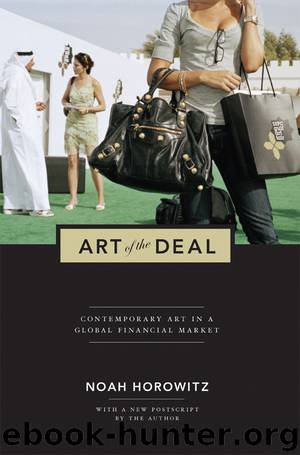Art of the Deal by Noah Horowitz

Author:Noah Horowitz
Language: eng
Format: epub
Publisher: Princeton University Press
Published: 2015-04-19T16:00:00+00:00
Social Barriers
Art investment funds, of course, view these inefficiencies optimistically. Leveraging their quantitative and qualitative expertise, alongside their sizable purchasing power, they argue that such conditions bear rich speculative opportunities.122 Today’s art investment pioneers, like their hedge fund counterparts, are thus staking their claims on the prospects of the efficient/inefficient rift.
But current art funds are not the first to highlight the economic benefits of this market’s inefficiency. In 1991 economist Richard Coffman argued that this attribute of the art economy, which stems from pervasive asymmetric information, implied that “investors have a reasonable chance of making above normal returns.”123 Asymmetric information may benefit the seller who knows more about the good than the buyer (i.e., provenance or condition) and thus knowingly withholds such information when transacting, or it privileges the informed buyer who makes undervalued acquisitions and resells at a premium.124
This latter scenario is precisely that championed by art funds. “Everyone who has tried this before has either been too financially focused, and didn’t understand the art,” reckons Taub, “or too art focused—without understanding the financials.”125 The delicate balance reconciled across analytical investment metrics, art-historical knowledge, and “insider” savvy is strategically intended to help these funds profit from such informational deficiencies. Nevertheless, bargains may be limited at auction due to exorbitant fees, a point Coffman emphasizes.126 To truly reap the financial rewards of asymmetric information and market inefficiency, art investors must transact outside the auction sector and in the private markets instead.
Olav Velthuis’s research on the contemporary art economy suggests that this objective will be challenging for funds to achieve. Drawing on empirical data—interviews with contemporary art dealers in Amsterdam and New York—and the field of economic sociology, he argues that free-market transacting is restricted in the art economy due to deeply embedded cultural conventions.127 The foundations of Velthuis’s argument are not unique—revisionist accounts of other financial markets have been similarly articulated—nor does he discuss art funds. But his approach to the art economy is fresh and yields some important ways of reconciling our analysis of art investing (itself exemplary of free-trade ideology) as well as our broader enquiry into the relationship between art and global finance.128
The single most penetrating concept he deploys is what sociologist Viviana Zelizer calls “circuits of commerce.” Velthuis elaborates:
Rather than being solely motivated by utility maximization, members of … circuits may be inspired by concerns of status, care, love, pride or power. In daily economic life, they not only need to collect information and make decisions on its basis, they also need to make sense of the behavior of the partners they engage in trade relationships with. This behavior may not be universally rational, but it does make sense within the circuits that economic actors inhabit.129
The applicability of this statement to the art market is considerable. In a system where artist-dealer-collector relations are highly personal, even familial, economic decisions are actively restrained by social dynamics.130 Because of this, the art world circuit (where profit is but one factor in a more elaborate cultural system: economic plus
Download
This site does not store any files on its server. We only index and link to content provided by other sites. Please contact the content providers to delete copyright contents if any and email us, we'll remove relevant links or contents immediately.
Life 3.0: Being Human in the Age of Artificial Intelligence by Tegmark Max(4492)
The Sports Rules Book by Human Kinetics(3581)
ACT Math For Dummies by Zegarelli Mark(3558)
The Age of Surveillance Capitalism by Shoshana Zuboff(3411)
Blood, Sweat, and Pixels by Jason Schreier(3127)
Unlabel: Selling You Without Selling Out by Marc Ecko(2974)
Urban Outlaw by Magnus Walker(2945)
Hidden Persuasion: 33 psychological influence techniques in advertising by Marc Andrews & Matthijs van Leeuwen & Rick van Baaren(2770)
The Pixar Touch by David A. Price(2735)
Bad Pharma by Ben Goldacre(2722)
Project Animal Farm: An Accidental Journey into the Secret World of Farming and the Truth About Our Food by Sonia Faruqi(2654)
Brotopia by Emily Chang(2586)
The Content Trap by Bharat Anand(2488)
Slugfest by Reed Tucker(2411)
The Airbnb Story by Leigh Gallagher(2363)
Kitchen confidential by Anthony Bourdain(2298)
Coffee for One by KJ Fallon(2002)
Smuggler's Cove: Exotic Cocktails, Rum, and the Cult of Tiki by Martin Cate & Rebecca Cate(1977)
Beer is proof God loves us by Charles W. Bamforth(1914)
